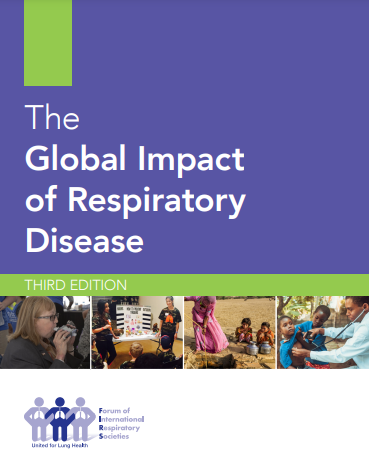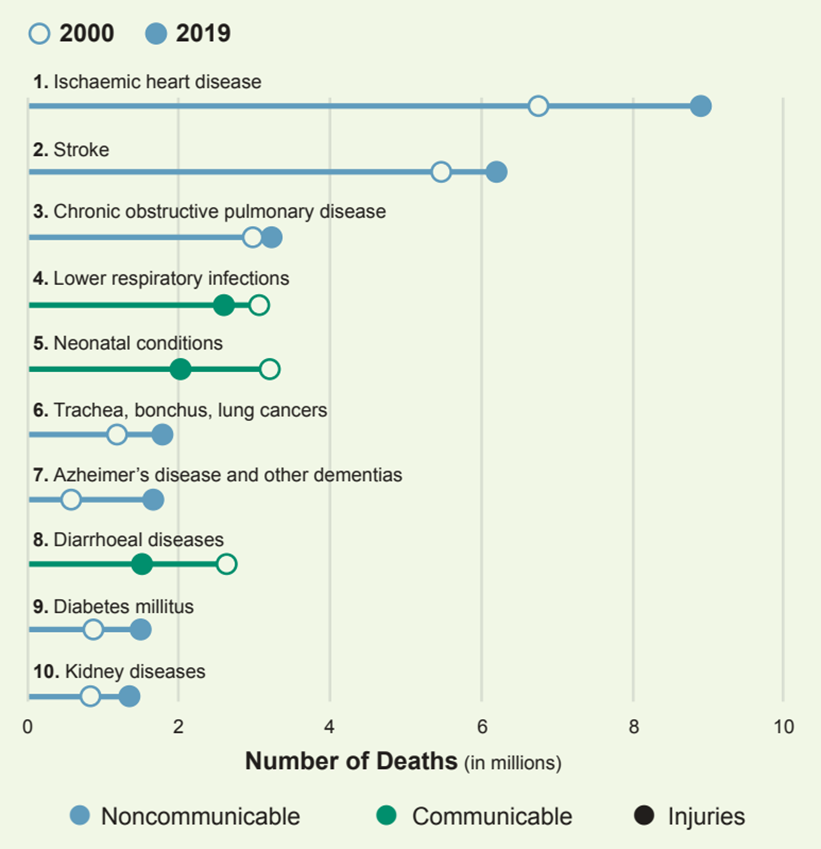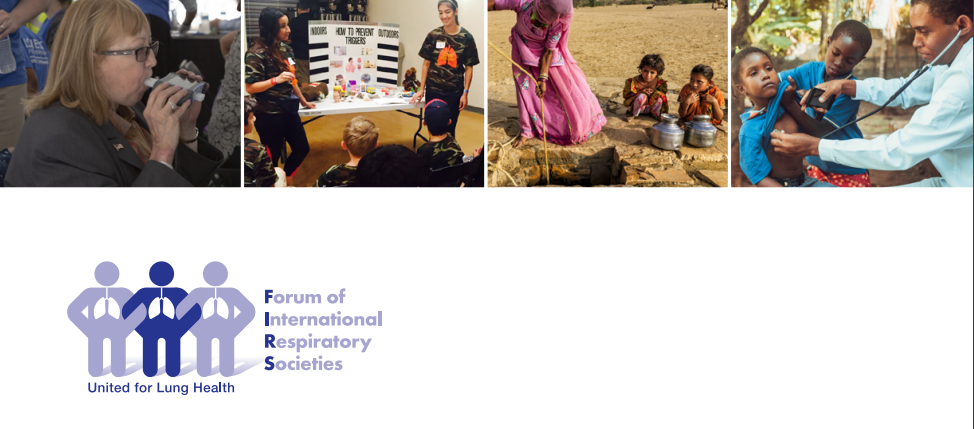Site Editor:
Joaquim Cardoso MSc.
The Health Strategist — research, strategy and implementation
September 26, 2022
This is an excerpt of the report below.
The Global Impact of Respiratory Disease — 2021
Forum of International Respiratory Societies (FIRS)
3rd edition
September 2021
EXECUTIVE SUMMARY
We take our breathing and our respiratory health for granted, but our lungs enable us to live, laugh, love, and enjoy activities.
The lungs are vital organs and are vulnerable to airborne infection and injury.
Respiratory diseases are leading causes of death and disability in the world.
- Nearly 200 million people, or 4% of the world’s population, have COPD and 3.2 million die of it each year[1] [2] [3], making it the third-leading cause of death worldwide.
- Asthma affects more than 350 million people worldwide[4] and is the most common chronic disease of childhood worldwide.
- Pneumonia kills more than 2.4 million people annually[5] and is a leading cause of death among children younger than 5 years outside the neonatal period and adults older than 65 years[6].
- More than 10 million people develop TB and 1.4 million die of it each year, making it the most common lethal infectious disease next to the COVID-19 pandemic[7].
- The current pandemic has claimed the lives of more than 4.5 million people, largely all from respiratory causes[8].
- Lung cancer kills 1.8 million people each year and is the deadliest of all cancers[9].
In 2019, respiratory disease comprised three of the top 10 causes of death according to the World Health Organization (WHO), leading to more than 8 million deaths annually[10].
Moreover, at least 2.4 billion people are exposed to indoor air pollution[11], and 90% of all people breathe outdoor air that exceeds WHO guideline limits, especially in low- and middle-income countries[12], …
… and more than 1.3 billion are exposed to tobacco smoke[13].
The truth is that many of us are naïve to these stark realities, but the numbers do not lie.
Fortunately, most respiratory diseases are preventable by improving the quality of the air we breathe.
Common sources of unhealthy air are tobacco smoke, indoor and outdoor air pollution, and air containing microbes, toxic particles, fumes, or allergens.
- Reducing tobacco consumption is the most important first step.
- Controlling unhealthy air in the workplace will prevent occupational lung disease.
- Strengthening vaccination programs can prevent many types of pneumonia, including those caused by SARS-CoV-2.
- Improving respiratory health also entails strengthening health-care systems, using established guidelines for health promotion and disease prevention and management, training medical personnel, research, and informing the public about the importance of lung health.
Common sources of unhealthy air are tobacco smoke, indoor and outdoor air pollution, and air containing microbes, toxic particles, fumes, or allergens.
Prevention, control, and cure of these diseases and promotion of respiratory health must be a top priority in global decision-making and action in the health-care sector.
These goals are achievable, and the control, prevention, and cure of respiratory diseases are among the most important and cost-effective health interventions available.
The Forum of International Respiratory Societies (FIRS) asserts that alleviating the burden of respiratory disease must be a leading strategy to achieve its Sustainable Development Goals by 2030 and a willing obligation for nations to achieve[14] [15].
The world is focused, most appropriately, on the current COVID-19 pandemic [2021].
Vaccinations have proven exceedingly effective and offer significant hope, and we need to enable the global distribution and administration of effective vaccines for all.
It seems probable that a long-term vaccination strategy will include regular vaccine boosters to protect against variants.
However, much more work must be done before the current pandemic abates and, perhaps even more importantly, for the world to be prepared for and potentially prevent future pandemics.
The purpose of this report is to call attention to the importance of overall respiratory health in the world and to raise it to be a top priority in global decision-making.
Let us not take our breathing and respiratory health for granted.

INTRODUCTION
The lung is the internal organ most vulnerable to infection and injury from the external environment because of its constant exposure to particles, chemicals, and infectious organisms in ambient air.
Globally, at least 2.4 billion people are exposed to the toxic smoke of biomass fuel, typically inefficiently burned in poorly ventilated indoor stoves or fireplaces[16].
Air pollution levels remain dangerously high in many parts of the world.
Recent data from WHO show that nine of 10 people breathe air containing high levels of pollutants and that 7 million people die every year from exposure to polluted air[17].
More than 1.3 billion people worldwide use tobacco, exposing many others via secondhand exposure[18].
Tobacco use causes 8 million avoidable deaths per year, mostly from cardiovascular or respiratory diseases[19].
Although respiratory impairment causes disability and death in all regions of the world and among all social classes, poverty, overcrowding, environmental exposures, and generally poor living conditions increase vulnerability to this large group of disorders.
Respiratory diseases impose an immense worldwide health burden, with five of these being the most common causes of severe illness and death worldwide[20] [21] [22] [23] [24]:
- 1.An estimated 200 million people have COPD, from which about 3.2 million die each year, making it the third-leading cause of death worldwide [25] [26] [27].
- 2.Asthma afflicts more than 350 million people worldwide and is the most common chronic disease of childhood[28].
The prevalence of asthma has been rising for the past three decades[29].
- 3.For decades, acute lower respiratory tract infections have been among the top causes of death and disability among children and adults.
Although its burden is difficult to quantify, lower respiratory tract infection causes more than 2.4 million estimated deaths annually and is a leading cause of death among children younger than 5 years outside the neonatal period and adults older than 65 years[30].
Moreover, acute lower respiratory tract infection in children predispose them to chronic respiratory disease later in life.
Worldwide, annual epidemics of influenza are estimated to result in about 3 million to 5 million cases of severe illness and about 290,000 to 650,000 respiratory deaths[31].
At the time of this writing, the COVID-19 pandemic has affected nearly 140 million worldwide and resulted in the deaths of more than 4.5 million people[32] [33].
- 4.In 2019, 10 million people developed TB and 1.4 million people died from it[34].
- 5.The most common lethal neoplasm in the world is lung cancer, which resulted in the deaths of 1.8 million people in 2020[35].
Leading causes of death globally

Source: WHO Global Health Estimates
In addition to these top five, there are several respiratory disorders whose burden is also great.
- More than 1 billion people experience sleep-disordered breathing[36].
- Millions live with pulmonary hypertension[37].
- Millions are affected by occupational lung diseases.
In 2019, respiratory disease comprised three of the top 10 causes of death according to the WHO, leading to more than 8 million deaths annually,
- with COPD being the third-leading cause of death,
- lower respiratory tract infections being the fourth, and
- cancers of the trachea, bronchi, and lungs being sixth[38].
However, the impact on society is even greater.
In the 2020 Global Burden of Disease Report, four of the “big five” lung diseases are among the top 20 causes of disability-adjusted-life-years after analyzing all ages and all levels of country income[39].
Lower tract respiratory infection is the fourth cause, COPD is the sixth, TB is the 12th, and lung cancer is the 17th-leading cause.
Even more distressing is the enormous disability and suffering that living with these illnesses can cause.
Those who are most disadvantaged suffer most from poor health.
With this awareness, the United Nations created the sustainable development goals to raise living standards globally[40] [41] [42].
Goal 3 of the sustainable development goals is to “ensure healthy lives and promote well-being for all at all ages.” FIRS is part of a global effort to call for action to address the huge burden of respiratory diseases.
FIRS asserts that alleviating this burden should be a leading strategy of the sustainable development goals and a requirement for nations to achieve these goals[43] [44].
FIRS has previously published reports, including prior editions of this ‘Global Impact of Respiratory Diseases’ report calling for improvements in health-care policies, systems, and care delivery, as well as providing direction for future research[45] [46].
This report aims to provide an update on what has happened in the intervening years.
Although some progress has been made, three of the big five areas of respiratory disease discussed in this report remain among the top 10 causes of global mortality, and all are among the leading causes of morbidity.
These truths confirm the stark reality that far more work must be done to reduce the global burden and consequences of respiratory diseases.
These truths confirm the stark reality that far more work must be done to reduce the global burden and consequences of respiratory diseases.

FOREWORD
by Arzu Yorgancioglyu
Noncommunicable diseases, including heart disease, stroke, cancer, diabetes, and chronic lung disease, are collectively responsible for almost 70% of all deaths worldwide.
Almost three-quarters of all deaths related to noncommunicable diseases and 82% of the 16 million premature deaths (ie, death <70 years of age) occur in low- and middle-income countries.
Most of these diseases — especially chronic respiratory diseases — are preventable.
Rather than solely dealing with a biomedical approach in diagnosis and treatment, focusing on social determinants of health such as tobacco use, air pollution, physical inactivity, the harmful use of alcohol, unhealthy diets, poverty, occupational exposure, and gender inequalities can help prevent these diseases.
The COVID19 pandemic has showed us the vital importance of lungs; it mostly affects the lungs; death is most commonly caused by lung involvement; and healthy lungs are able to fight COVID better.
We have seen how a tiny virus can pose a threat to life when we disrupt the world’s natural life balance, resulting in millions of casualties.
Undoubtedly, SARS-CoV-2 not only caused deaths but also displaced many people globally with its economic, political and sociologic effects.
The owner of nature alone is not human, and any attempt to disrupt the health and harmony of the environment in which humans live will directly affect the health of humankind and other creatures.
The only gain we can achieve from COVID-19 should be to change our perspective, our values, and, ultimately, our mentality.
Let us change, change for a new world, for another world, for our future…
The Global Alliance against Chronic Respiratory Diseases (GARD) is a voluntary alliance of national and international organizations, institutions, and agencies committed to the vision of a “world where all people breathe freely,” established by the World Health Organization (WHO) with the goal to reduce the global burden of chronic respiratory diseases.
GARD had a new governmental structure in 2019 and invited all international societies to liaise with GARD, with the strong branding of the WHO and the motto, “If we work together to achieve our common goals, WE CAN MAKE A REAL DIFFERENCE.”
It is my great pleasure and opportunity to have the Forum of International Respiratory Societies (FIRS) representative act as an advisor to the GARD chair and Global Initiative for Asthma (GINA) & Global Initiative for Chronic Obstructive Lung Disease (GOLD) representatives in the GARD Executive Committee.
I would like to congratulate FIRS for this very important and comprehensive report, which shows the global impact of major respiratory diseases. We need advocacy and wide dissemination of this report to increase awareness and hopefully reduce the burden of these diseases.
“Live a life that leaves the world a better place because you made a difference.”, — Janet N. Spriggs
“I believe FIRS is leading us to make a difference.” — — Arzu Yorgancıoğlu, GARD Chair
References and additional information.
See the original publication
WRITING COMMITTEE
Stephanie Levine (co-chair)
UT Health- San Antonio and South Texas Veterans Health Care System San Antonio, Texas, USA
Darcy Marciniuk (co-chair)
University of Saskatchewan Saskatoon, SK, CANADA
Amro Agla
Beth Israel Deaconess Medical Center Boston MA, USA
Juan C. Celedón
University of Pittsburgh Pittsburgh, Pennsylvania, U.S.A.
Kwun Fong
The Prince Charles Hospital, Brisbane QLD AUSTRALIA UQ Thoracic Research Centre Brisbane QLD AUSTRALIA
Robert Horsburgh
Boston University School of Public Health, Boston MA, USA
Atul Malhotra
Pulmonary, Critical Care and Sleep Medicine, UC San Diego La Jolla, CA, USA
Refiloe Masekela
University of KwaZulu Natal Durban, South Africa
Kevin Mortimer
Liverpool School of Tropical Medicine Liverpool, UK
Hellen Redde
The Woolcock Institute of Medical Research and the University of Sydney, Sydney, AUSTRALIA
Mary Rice
Beth Israel Deaconess Medical Center Boston MA, USA
Anita Simonds
Royal Brompton and Harefield Hospital, NHLI, London UK
Lynn Tanoue
Yale School of Medicine New Haven, CT, USA
Heather Zar
Red Cross Childrens Hospital University of Cape Town, South Africa
Originally published at: https://www.firsnet.org
Cite this publication as:
Forum of International Respiratory Societies. The global impact of respiratory disease. Third Edition. European Respiratory Society, 2021. Accessed 22 September, 2021.












